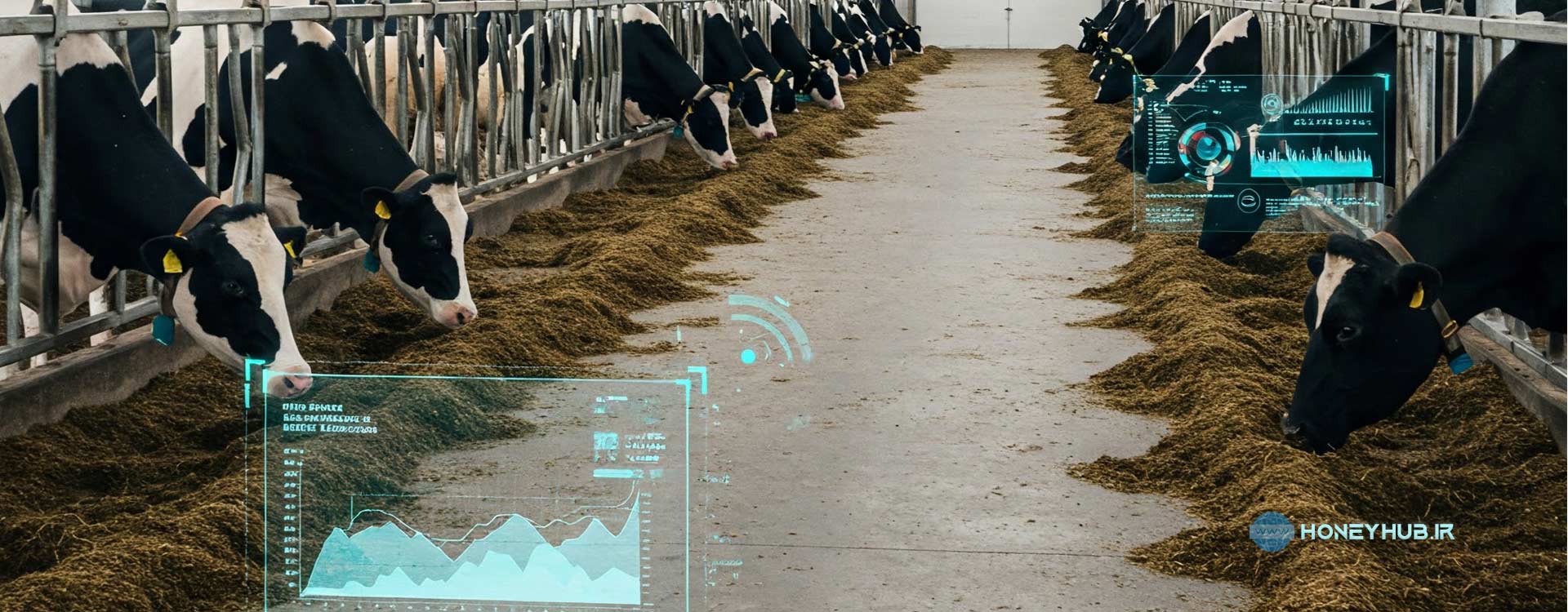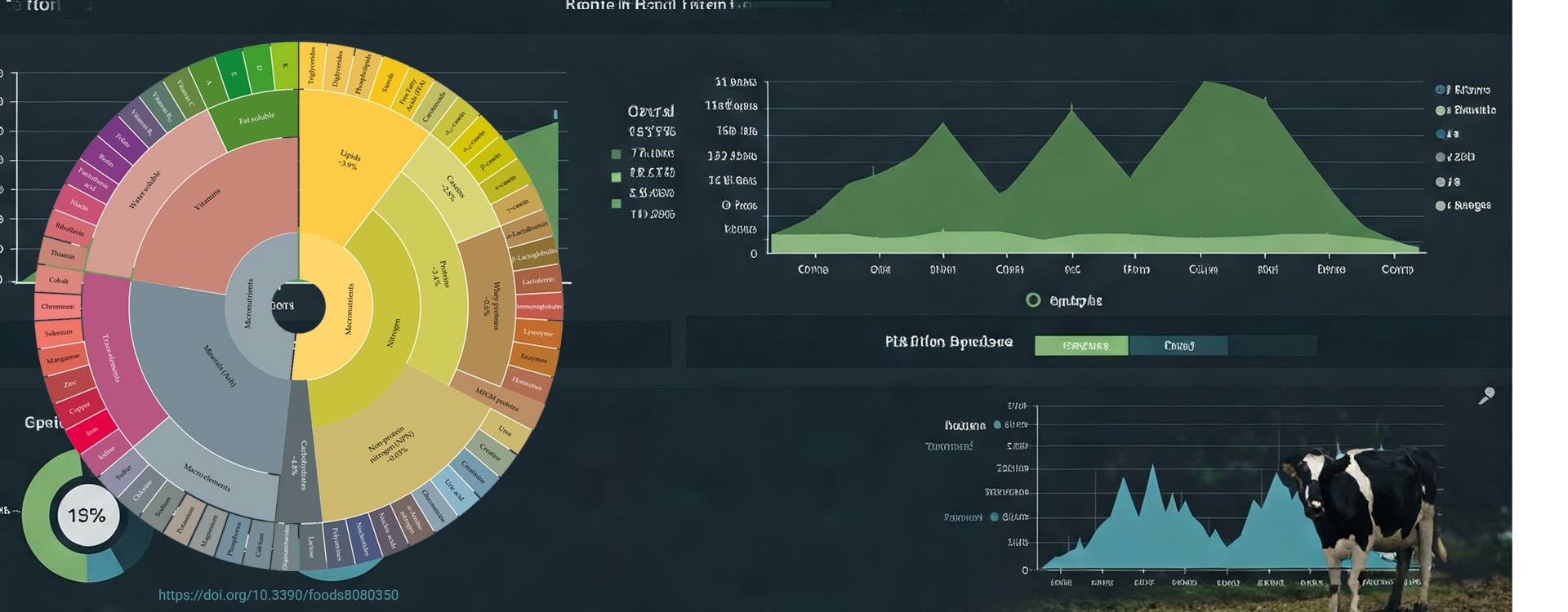Does your mozzarella refuse to stretch or just burn? The secret is science. From "pasta filata" to the crucial role...
AI-Powered Feed Optimization: Revolutionizing Dairy Farm Success
Revolutionizing Dairy Farms: How AI Optimizes Feed for Success
In the ever-evolving world of agriculture, dairy production stands at the cusp of a significant transformation. Artificial intelligence (AI) is no longer a futuristic concept but a tangible tool reshaping traditional practices. One of the most impactful applications of AI lies in the realm of feed optimization. By leveraging the power of data analysis and machine learning, AI-based Decision Support Systems (DSS) are paving the way for more efficient, healthier, and sustainable dairy farming. This post delves into the crucial aspects of these innovative systems, exploring their objectives, underlying technologies, data sources, AI techniques, and the profound benefits they offer.

1. Core Objectives of AI-Based Feed Optimization
At the heart of AI-driven feed optimization lies a set of key objectives aimed at enhancing various facets of dairy production. These goals are interconnected and contribute to a more holistic and efficient farming operation.
Maximize Milk Production & Quality
The primary goal is to fine-tune the nutritional composition of the feed to not only increase the overall milk yield per cow but also to improve its quality. This includes optimizing the levels of fat, protein, and other essential components that contribute to the nutritional value and marketability of the milk. AI algorithms analyze historical data and real-time information to suggest precise adjustments to the feed mix, ensuring cows receive the optimal balance of nutrients for peak performance.

AI-Powered Animal Nutrition Insights: This dashboard visualizes key data points related to animal nutrition, likely including feed intake, nutrient levels, and performance indicators. The charts and graphs provide a clear overview, enabling informed decisions for optimal animal health and productivity.
Reduce Feed Costs
Feed represents a significant portion of the operational expenses in dairy farming. AI-based DSS aims to minimize these costs by optimizing feed formulations to reduce waste and ensure that nutritional requirements are met without overfeeding. By analyzing feed prices and the specific needs of the herd, AI can suggest cost-effective alternatives and precise quantities, leading to substantial savings for farmers.
Improve Animal Health & Longevity
Optimal nutrition is directly linked to the health and well-being of dairy cows. AI systems can help prevent metabolic disorders such as ketosis and acidosis by ensuring a balanced diet that supports healthy rumen function. By monitoring individual cow data and predicting potential nutritional deficiencies, AI contributes to a healthier herd with increased longevity and reduced veterinary costs.
Sustainability & Environmental Impact
Modern agriculture is increasingly focused on sustainability. AI-driven feed optimization plays a crucial role in reducing the environmental footprint of dairy farming. Precision feeding, guided by AI, can lower methane emissions from cows and reduce nitrogen excretion in manure, contributing to a more environmentally responsible and sustainable production system.
2. Key Technologies Used
The effectiveness of AI-based feed optimization relies on a synergy of several cutting-edge technologies that work together to collect, analyze, and act upon vast amounts of data.
Machine Learning (ML) & Predictive Analytics
Machine learning algorithms form the core of these systems. Regression models are used to predict milk yield based on feed composition and other factors. Reinforcement learning techniques enable the system to dynamically adjust feed based on real-time outcomes and learn from the results, continuously improving its recommendations.
Computer Vision & Sensor Data
Computer vision, coupled with cameras strategically placed in the farm, can monitor feed intake and ensure efficient consumption. RFID tags attached to individual cows can provide data on their feeding behavior. Additionally, AI-powered image analysis can be used for body condition scoring, providing insights into the nutritional status of the animals.
IoT & Real-Time Monitoring
The Internet of Things (IoT) plays a vital role in collecting real-time data. Wearable sensors can monitor crucial health indicators like rumen pH and activity levels. Automated feeders integrated with AI can deliver precise portions of feed to individual cows based on their specific needs, as determined by the system.
Digital Twins & Simulation Models
Digital twins, which are virtual representations of individual dairy cows or the entire herd, allow for the simulation of different feed impacts without affecting the real animals. These models help in predicting outcomes and optimizing feed strategies before implementation.
3. Data Sources for AI Models
The accuracy and effectiveness of AI models heavily depend on the quality and variety of the data they are trained on. A comprehensive range of data sources contributes to robust and reliable feed optimization.
Historical Feed Data
Past records of feed formulations and their corresponding outcomes in terms of milk production, animal health, and costs provide valuable insights for training AI models.
Animal-Specific Data
Information such as breed, weight, age, lactation stage, and health records for each individual cow is crucial for personalized feed recommendations.
Environmental Factors
External conditions like temperature, humidity, and stress indicators can influence feed intake and animal performance, making them important data points for the AI system.
Milk Production Metrics
Data on milk yield, composition (fat, protein, somatic cell count), and other quality parameters are essential for evaluating the impact of different feed strategies.
Economic Data
Information on feed prices, transportation costs, and other operational expenses is vital for the AI to make cost-effective feed optimization decisions.
4. AI Techniques Applied
A range of sophisticated AI techniques are employed to analyze the diverse data sources and generate optimal feed recommendations.
Supervised Learning
Algorithms like Random Forest and Neural Networks are used to predict optimal feed mixes based on labeled historical data, where the input (feed composition, animal data) is mapped to the output (milk yield, health outcomes).
Unsupervised Learning
Techniques such as Clustering can identify patterns in feeding behavior or animal characteristics that might not be immediately apparent, leading to new insights for optimization.
Optimization Algorithms
Algorithms like Genetic Algorithms and Linear Programming are used to find the best solutions for minimizing feed costs while meeting the complex nutritional requirements of the dairy herd.
Natural Language Processing (NLP)
NLP can be employed to analyze unstructured text data such as veterinary reports or research papers to extract valuable information and insights relevant to feed optimization and animal health.
5. Benefits of AI-Driven Feed Optimization
The adoption of AI-driven feed optimization systems brings a multitude of significant advantages to dairy farmers, impacting their profitability, the health of their animals, and their environmental responsibility.
6. Challenges & Considerations
While the potential of AI in feed optimization is immense, there are several challenges and considerations that need to be addressed for successful implementation.
7. Future Research Directions
The field of AI-based feed optimization is continuously evolving, with several promising avenues for future research and development.
Edge AI for Real-Time Feeding Adjustments
Developing AI models that can be processed directly on farm devices (edge computing) will enable faster, real-time adjustments to feeding based on immediate data.
Blockchain for Transparent Feed Supply Chains
Integrating blockchain technology can provide greater transparency and traceability in the feed supply chain, ensuring the quality and origin of feed ingredients.
Integration with Robotic Feeding Systems
Further integration of AI with robotic feeding systems will lead to more autonomous and efficient feed management.
Multi-Objective Optimization
Future research will focus on developing AI models that can simultaneously optimize multiple objectives, such as cost-effectiveness, animal health, and environmental sustainability.
Conclusion: The Intelligent Future of Dairy Feeding
In conclusion, AI-based Decision Support Systems for feed optimization represent a paradigm shift in dairy production. By harnessing the power of artificial intelligence, farmers can achieve unprecedented levels of efficiency, improve the health and productivity of their herds, and contribute to a more sustainable future for the industry. As technology continues to advance, these intelligent systems will undoubtedly become indispensable tools for modern dairy farms, paving the way for a smarter, healthier, and more prosperous future.
Summary of AI-Based Feed Optimization
To provide a concise overview of the key aspects discussed, the following table summarizes the core elements of AI-driven feed optimization in dairy production.
| Aspect | Description | Key Benefits |
|---|---|---|
| Core Objectives | Maximize milk production & quality, reduce feed costs, improve animal health & longevity, enhance sustainability. | Increased profitability, better resource utilization, healthier herds, reduced environmental impact. |
| Key Technologies | Machine Learning, Predictive Analytics, Computer Vision, Sensor Data, IoT, Real-Time Monitoring, Digital Twins, Simulation Models. | Data-driven insights, automated monitoring, precise interventions, virtual experimentation. |
| Data Sources | Historical feed data, animal-specific data, environmental factors, milk production metrics, economic data. | Comprehensive understanding of farm operations and animal needs. |
| AI Techniques | Supervised Learning, Unsupervised Learning, Optimization Algorithms, Natural Language Processing. | Accurate predictions, pattern detection, cost-effective solutions, information extraction. |
| Benefits | Higher profitability, precision nutrition, early disease detection, sustainability gains, automation & labor savings. | Improved farm efficiency, animal welfare, and environmental responsibility. |
| Challenges | Data quality & integration, model interpretability, farm-specific adaptation, regulatory & ethical issues. | Areas requiring careful attention for successful implementation. |
| Future Directions | Edge AI, blockchain for feed supply, integration with robotics, multi-objective optimization. | Potential for further advancements and more sophisticated systems. |
Leave a comment
Log in to post comments
Related posts
 Why does pollen improve your health?
Why does pollen improve your health? 10 Ways to Consume Bee Pollen
10 Ways to Consume Bee Pollen



















Latest comments